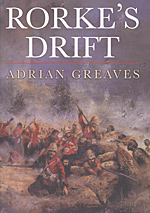 Cassell, 2002, $29.95, ISBN 0-304-35960-2, 446 pgs., hardback
Cassell, 2002, $29.95, ISBN 0-304-35960-2, 446 pgs., hardback
The first 200 pages of this book deals directly with a narrative of the battle, starting with an overview of the war and opening battle of Isandlwana, and then moving onto Rorkeís Drift proper. The next 200 pages reads more like archive material than prose. Thatís not a knock, only an acknowledgement that it is different.
Rorkeís Drift, a Swedish missionary outpost, sits on one of the few good crossings of the Buffalo River separating Natal from Zululand. One of the 1879 British columns crossed over the Drift, only to suffer a slaughter of half of it at Isandlwana while the other half was out looking for the Zulu army. The 139 or so soldiers manning Rorkeís Drift, used as a supply point, were about to meet 4,000 Zulus. The 17 pages that describe the attack, including six diagrams/maps, offer an excellent recap of the fight.
The last 200 pages offer biographical profiles of the officers and some soldiers, medical records of various soldiers, medal citations, and even a visitorís guide to the battlefield. Of note are various contemporary reports written about the battle, and an analysis of the controversy over who actually wrote them. If youíre doing research on Rorkeís Drift, these are invaluable.
Also notable is a small chapter examining claims about what rifles the Zulus used against the British. Itís a neat little summation, backed by archaeological investigations.
All in all, Rorkeís Drift is a bit of a misnomer as a title. The book covers more than that battle, although the last 200 pages of research concentrate on various aspects of the battle. Greaves certainly provides much to think about, and the particular battle chapters show an absolutely superb mix of maps and prose to detail the battle.
Back to List of Book Reviews: Colonial Era
Back to Master Book Review List
Back to Master Magazine List
© Copyright 2003 by Coalition Web, Inc.
This article appears in MagWeb.com (Magazine Web) on the Internet World Wide Web.
Other articles on military history and related topics are available at http://www.magweb.com